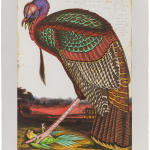-
Artworks


WALTON FORD
Benjamin's Emblem, 2000Etching and aquatint with drypoint.
Signed, dated and numbered in an edition of 50.
Printed on white Somerset Satin paper by Peter Pettengill at Wingate Studio, Hinsdale, New Hampshire.
Published by Blue Heron Press Inc., New York.Plate: 91.4 x 61 cm (36 x 24 in)
Sheet: 111.8 x 78.7 cm (44 x 31 in)"ln 1784, the Congress of the newly established United States sought an appropriate heraldic symbol for the new Federal govemment. As the discussions focused on the bald eagle, Benjamin Franklin proposed that Congress con-sider the merits of the native turkey. ln a letter to his daughter he wrote that I wish the bald eagle had not been chosen as the representative of our country; he is a bird of bad moral character, like those among men who live by sharping and robbing... The turkey is a much more respectable bird."
One of the grandest plates in Audubon's The Birds of America (London, 1827-33) is the wild turkey. What if Franklin had prevailed in his choice of a natural bird? This is the initial premise underlying Walton Ford's Benjamin's Emblem. Unlike the noble fowl of Audubon's plate that epitomizes the virtues that Franklin deemed essentialfor the individual citizen and the nation, Ford's turkey has evolved into a leaner and meaner, more bellicose bid, fully imbued with the character of the eagle. This turkey is depicted at the kill; in his claws is the hapless corpse
of the native, and now extinct, Carolina parrot whose communal habits made it easy prey for hunters. Ford's image raises a second question: Has America lost sight of its essential nature outlined in the Constitution and the Bill of Rights? (Ponder.)"
– David Kiehl



